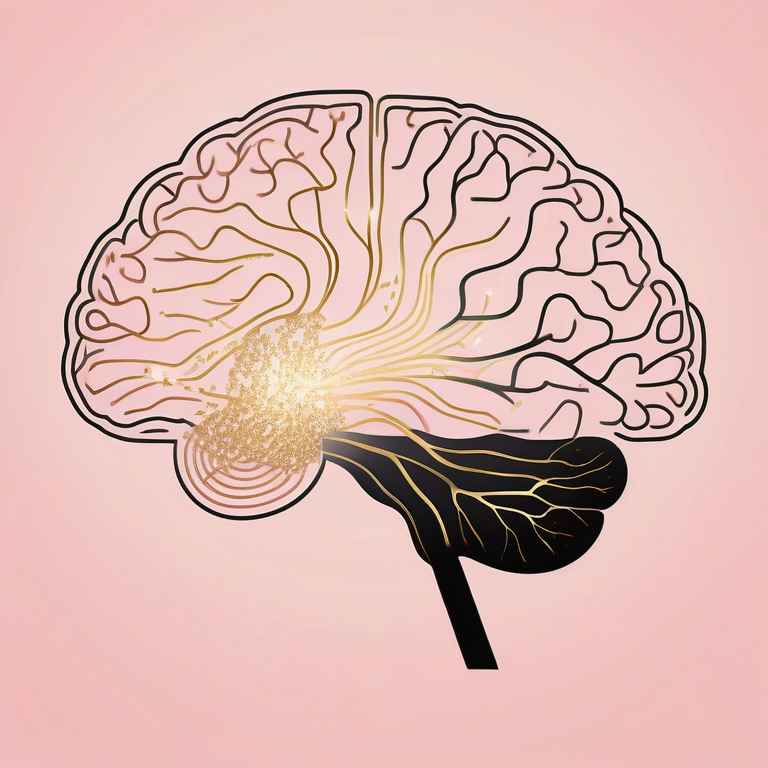This blog post will dive into the interesting topic of neuromelanin and how it affects brain health. Neuromelanin is a dark pigment found in certain areas of the brain. It is becoming more known for its different roles in both healthy brain function and neurodegenerative disorders. We will discuss how neuromelanin is made, its properties, and how it might relate to brain health.
Understanding Neuromelanin: An Overview
Neuromelanin is a dark pigment found in the human brain. It is mostly located in dopaminergic neurons. This gives a unique dark color to areas like the substantia nigra and locus coeruleus. These two regions are important for motor control and thinking.
Neuromelanin starts to build up in early childhood and keeps accumulating throughout life. Its structure is complex and it is similar to melanin, the pigment that gives color to skin, hair, and eyes.
The Synthesis of Neuromelanin
The synthesis of NM happens in dopaminergic neurons. It starts with L-DOPA, which is a key ingredient for the neurotransmitter dopamine. Important enzymes, like tyrosine hydroxylase and aromatic acid decarboxylase, change L-DOPA into other molecules that make up neuromelanin.
Also, oxidative processes in the neuron help create the NM pigment. This happens mainly in sections called synaptic vesicles and endosomes. When there is excess dopamine, it gets broken down. This breakdown leads to molecules that come together to form neuromelanin.
Neuromelanin and Brain Health
Neuromelanin is gaining interest among scientists because of its protective role in keeping the brain healthy. One of its key jobs is to fight oxidative stress. This is a harmful process that involves unstable molecules known as free radicals, which can hurt cells.
Neuromelanin works as a strong antioxidant. It binds to and neutralizes reactive oxygen species like hydrogen peroxide. This helps protect fragile brain cells, especially dopaminergic neurons, from damage and keeps their functions running smoothly.
Neuromelanin Imaging Techniques
Researchers can now see neuromelanin in the brain thanks to better imaging techniques. Electron microscopy, especially transmission electron microscopy, gives clear pictures of neuromelanin granules inside neurons.
Furthermore, magnetization transfer magnetic resonance imaging (MRI) is a safe method that detects the magnetic features of neuromelanin. These tools help scientists look at how neuromelanin is spread and how its levels change in real-life subjects.
Parkinson’s Disease and Neuromelanin
Researchers have found a strong link between neuromelanin and Parkinson’s disease. This disease affects the brain and causes problems with movement, such as tremors and stiffness. A key feature of Parkinson’s is the loss of dopaminergic neurons in the substantia nigra.
These specific neurons are where neuromelanin builds up the most. It is believed that the loss of neurons packed with neuromelanin plays a role in the disease. PD patients usually show lower levels of neuromelanin in their brains.
Neuromelanin and Other Neurological Disorders
Neuromelanin is being studied not just for Parkinson’s disease. It may also play a role in other neurodegenerative disorders. Researchers are looking into how it relates to problems like Alzheimer’s disease, which leads to problems with memory and thinking.
Recent studies indicate that neuromelanin might connect with toxic metals in the brain. By grabbing onto these metals, neuromelanin may stop them from building up in the brain. This could help protect the brain cells from damage. Overall, this points to a wider protective role for neuromelanin in neurodegenerative diseases.
Neuromelanin and Mental Health
The role of neuromelanin affects mental health. There is growing interest in how it may be connected to issues like depression and anxiety. Scientists are looking into whether changes in neuromelanin levels or how it works might affect these problems.
For example, if neuromelanin cannot protect the brain from oxidative damage in areas that control mood, it might be important. More research is needed to understand how neuromelanin relates to mental health.
The Biochemical Properties of Neuromelanin
Neuromelanin has special biochemical features that help it perform its functions. NM synthesis happens in special parts of neurons known as lipid bodies.
|
Property |
Description |
|
Structure |
It is a complex and varied polymer. |
|
Composition |
It includes indolequinone monomers, lipids, and metal ions. |
|
Solubility |
It does not dissolve in organic solvents. |
Neuromelanin can bind to metal ions, especially iron, which is important for its ability to fight off damage and protect cells. It can also connect with other metals and substances, making it an interesting molecule to learn about.
Environmental Factors Affecting Neuromelanin
New information shows that environmental factors may affect the levels and function of neuromelanin. Research on animals has linked certain toxic compounds, like pesticides and heavy metals, to changes in neuromelanin.
Also, studies indicate that organic solvents in workplaces might influence neuromelanin levels. These results point out the possible connection between environmental exposures and neuromelanin, which can affect brain health and diseases.
The Evolutionary Perspective of Neuromelanin
Exploring the evolutionary view of neuromelanin helps us understand why it is important:
- Neuromelanin exists in greater amounts in the human SN than in other animal species. This points to a possible role in how the human brain has changed over time.
- One idea is that neuromelanin helps protect against oxidative stress and harmful substances. This protection might have helped humans improve brain function and live longer.
Neuromelanin and the Aging Brain
Understanding how neuromelanin and brain aging are connected is very important:
- Neuromelanin levels go up as we get older. This could mean it plays a part in the normal aging process.
- Neuromelanin might protect us when we are young, but it could hurt brain cells as we age in some situations. This shows how complex the relationship is between neuromelanin, aging, and brain cell loss.
Innovative Research on Neuromelanin
Innovative research is helping us learn more about neuromelanin.
- Scientists are looking at its special characteristics, like its stable free radical structure, to understand how it works.
- New imaging methods, like paramagnetic resonance imaging, let researchers examine neuromelanin in living subjects. This gives us important information about its role in health and disease.
Therapeutic Approaches Targeting Neuromelanin
The discovery of neuromelanin’s role in brain health is leading to new treatment options targeting this interesting molecule:
- Researchers are looking into drugs that can change neuromelanin levels or boost its protective abilities.
- Studies with cell cultures and animals are testing the use of neuromelanin-based therapies to slow down disease progression in neurodegenerative disorders like Parkinson’s.
Ethical Considerations in Neuromelanin Research
As interest in neuromelanin grows, it is very important to think about ethics in research. When studies involve people, they need to give their informed consent. This means they should know the possible risks and benefits of joining neuromelanin studies.
Also, researchers have to protect people’s data. This is important when using imaging methods that might show private information about the brain. Past studies published in well-known journals, like Google Scholar, give guidelines for ethical issues in neuromelanin research.
Conclusion
In conclusion, looking into the role of neuromelanin in brain health shows a complicated connection between biochemistry, neurology, and aging. Learning about how it is made, how it can be seen, and its effects in neurological issues, like Parkinson’s disease, can lead to new and helpful treatments. The chemical properties of neuromelanin and the factors in our environment remind us that we need more research to improve mental health and manage issues related to aging. It is also important to think about ethics when doing research on neuromelanin, as it helps us better understand the complexities of brain health. Taking a complete approach to studying neuromelanin could change how we support and promote cognitive well-being in different groups of people.



